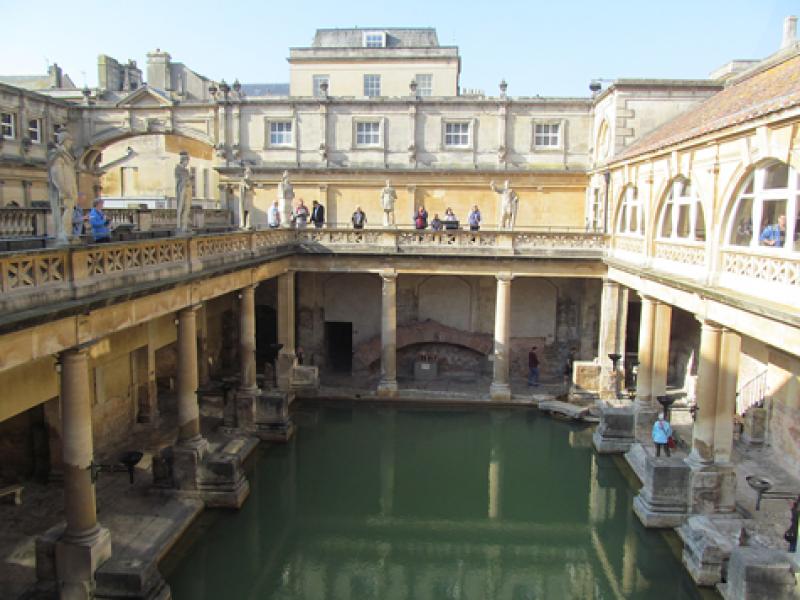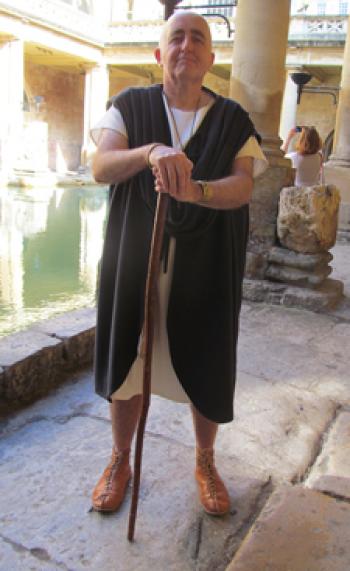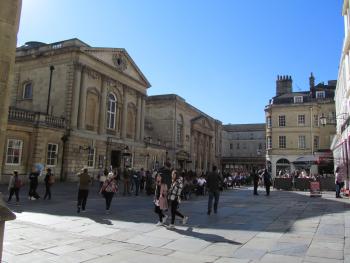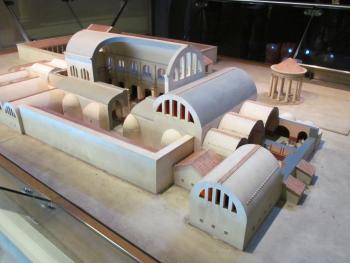SW England - Aquae Sulis
This item appears on page 43 of the June 2019 issue.
The Romans knew a good thing when they saw it. In this case, the good thing was the hot springs in what is now the city of Bath in southwestern England.
In the decades after the conquest of England in AD 43, following several invasions by Julius Caesar in the preceding century, the Romans turned a tribal sanctuary centered on hot springs into a thriving center that they called Aquae Sulis.
Before the Romans
Long before the arrival of the Romans, local Celtic tribal groups, including one called the Dobunni, venerated Sulis, a water deity, whom they regarded as the guardian-goddess of the hot springs. The springs served these Britons as both a religious center and as a curative bathing place because of the water’s rich mineral content.
Birth of Roman baths
With their love of baths, which proliferated not only in Rome but throughout the Roman Empire, and their knowledge of hydraulic engineering, the Romans enclosed the hot springs within lead-lined walls and constructed sluices and pipes to direct the spring water.
Rather than dethrone the Celtic goddess Sulis, the Romans simply identified her with Minerva, one of their own goddesses. The ancient sanctuary took on a new life as Aquae Sulis (Waters of Sulis). By about AD 75, not only were baths built but a temple was dedicated to Sulis Minerva, each located on either side of the hot springs.
The town that grew up around the Roman baths and the temple attracted merchants, traders, soldiers and local Britons, who came to buy, sell, worship and, of course, bathe.
After the Romans left England, in the early 5th century AD, the temple collapsed and the baths all but disappeared, known perhaps only to the few Saxon and medieval monks who inhabited the site in succeeding centuries.
Rebirth
Bath’s rebirth had to wait more than 1,300 years until the 18th century, when the city became a fashionable center. Georgian-style mansions were built, and those who wanted to see or be seen gathered in the elegant Pump Room, erected in 1706 practically on top of the old Roman baths.
In 1799, a second Pump Room replaced the earlier one. This latter period is the era associated with Jane Austen, and the Pump Room appears prominently in her novels “Persuasion” and “Northanger Abbey.” There were also Assembly Rooms for public gatherings.
Roman Bath
Much as I love Jane Austen and her novels, it is Roman Bath I was there to see.
Visitors enter the Roman baths (phone 44 1225 477 867, www.romanbaths.co.uk) through the elegant Palladian building in Abbey Churchyard. This building stands beside the equally elegant Pump Room.
For an adult, the entry fee for the baths is £14.40 (near $19) on weekdays and £16.20 on weekends. Hours vary depending on the month; it’s best to check online in advance of your visit.
The first bath visitors see upon entering the complex is the Great Bath, the largest of all the pools that Romans could immerse themselves in. It is rectangular, with walkways along the sides and with six alcoves. Steep steps lead down into the pool. Originally roofed over with timber and later with a brick-and-tile vault, it now lies open to the air.
Visitors can — and should — walk both on the terrace overlooking the Great Bath, which is lined with statues of Roman emperors and governors, as well as along the walkways beside the pool. On this lower level, guides dressed in Roman garb are happy to pose for photos or to answer questions about the baths.
Other baths
The Roman baths at Bath also had the conventional trio of frigidarium (cold bath), tepidarium (tepid bath) and caldarium (hot bath) that characterized Roman baths throughout the empire. Bathers could progress from cold to warm to hot, or they could go just to the Great Bath.
Nearby is a hypocaust, short terra-cotta pillars supporting a floor, with hot air from a furnace circulating among the pillars heating both the floors and the bath waters. In a dim corner between the Great Bath and the frigidarium/tepidarium/caldarium, the orange-colored waters of the hot spring gush out, feeding the baths.
Over the more than 300 years of the baths’ existence, there were at least four major building phases, with each phase making the layout of the baths more complicated. Additional baths were added, as were saunas. The full extent of the Roman baths is still unknown, much still buried beneath the streets of today’s city.
Museum
There is an on-site museum displaying some of the thousands of artifacts found, many during the excavations for the 1706 Pump Room and its later rebuilding.
The temple dedicated to Sulis Minerva no longer exists, but sections of the pediment were unearthed during the late-18th-century rebuilding of the Pump Room. The fragments are beautifully displayed using clever lighting to re-create what the original temple pediment must have looked like.
Pump Room visit
I have no idea what a Roman visitor to the baths might have done after a leisurely afternoon bathing. Perhaps linger awhile to chat with friends or maybe return home for a snooze. But I knew exactly what I wanted to do after my own visit to the Roman baths. I headed straight to the Pump Room, where, surrounded by 18th-century grandeur, either lunch or English tea can be enjoyed to the accompaniment of soft music.
Complete Pump Room tea with small sandwiches, fruit and buttermilk scones and pastries will cost £27 each. You probably won’t want dinner later on. It’s a good idea to reserve a table in advance to avoid the queue (phone 44 1225 444 477, www.romanbaths.co.uk). There are other complete teas offered as well, some including champagne.
Visitors can also sample the spa water from a fountain in the Pump Room. Note: It tastes vile. I recommend a tiny sip and then sitting down to savor your tea.
Other places to visit
Two other places not to miss in Bath are Bath Abbey, located a few steps away from the Roman baths, and No. 1 Royal Crescent, about a mile away.
Bath Abbey has its origins in the late 11th century, shortly after the Norman Conquest (1066), but its interior architecture and decoration is largely 16th-century.
The Royal Crescent is one of England’s most famous “streets.” Built by John Wood the Younger between 1767 and 1774, it comprises a semicircular collection of townhouses, one of which — No. 1 (phone 44 1225 428 126, www.no1royalcrescent.org.uk) — can be visited to see how a wealthy family lived in 18th-century Bath.
Since I’m a great fan of Jane Austen, I did visit the Jane Austen Centre and Regency Tea Room at 40 Gay Street (phone 44 1225 443 000; www.janeausten.co.uk). I’m sorry to say that I was disappointed with the center’s presentation of Austen’s life and works. However, there is an excellent gift shop as well as a tearoom that I didn’t have time to try.
If you go…
It’s only about a 90-minute train ride from London’s Paddington Station to Bath (called Bath Spa). It’s possible to make this a day excursion from London. Resist the urge and try to stay at least a night or two in Bath. My husband, Paul, and I spent two nights and felt that it should have been at least three or four nights.
The truly exceptional Royal Crescent Hotel at 16 Royal Crescent (phone 44 1225 823 333, www.royalcrescent.co.uk) gives visitors to Bath the opportunity to spend a few nights in Georgian-era splendor. Another plus is the excellent in-house restaurant.
During our 2-night visit in October 2018, rates ranged from £250 to £1,016, not including breakfast. Our Heritage room overlooking the huge lawn of the Royal Crescent cost £365 ($480) per night, including breakfast and taxes.
Jane Austen never had it so good.




